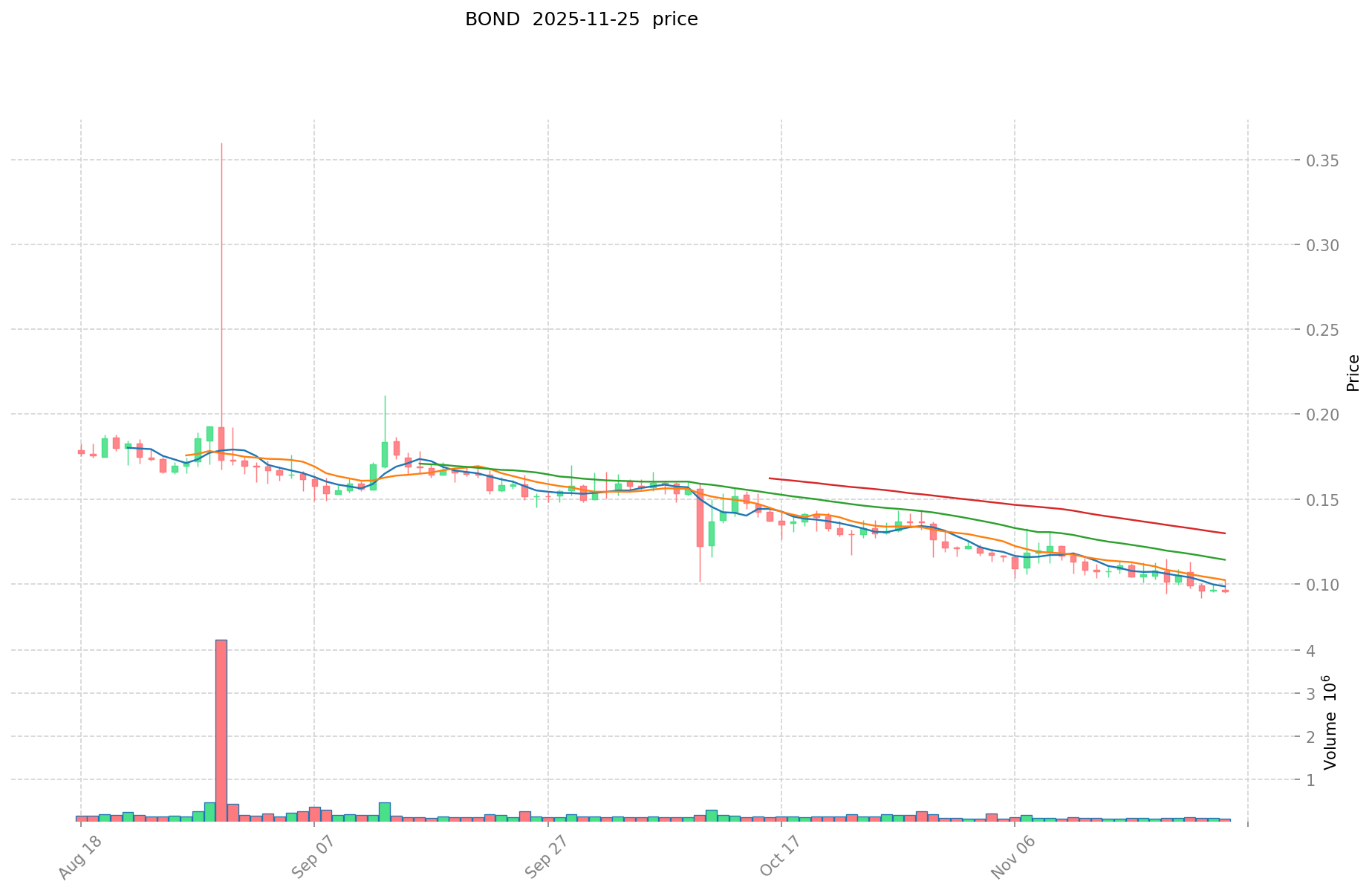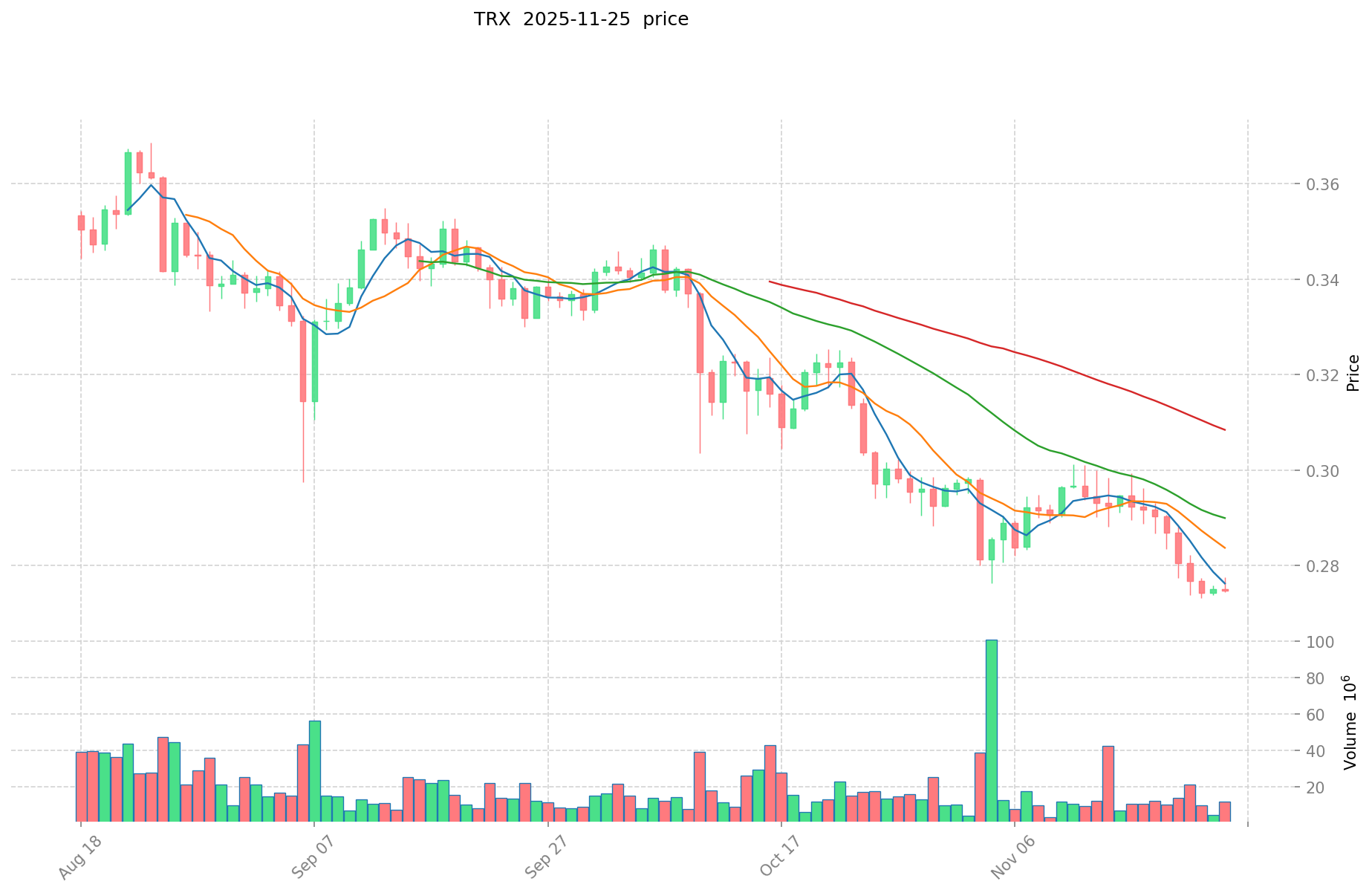BOND vs TRX: Comparing Investment Opportunities in Stable Assets and Cryptocurrencies
Introduction: Investment Comparison of BOND vs TRX
In the cryptocurrency market, the comparison between BOND and TRX has always been a topic that investors cannot avoid. The two not only have significant differences in market cap ranking, application scenarios, and price performance, but also represent different positioning in crypto assets.
BarnBridge (BOND): Launched in 2020, it has gained market recognition for its role as a volatility derivatives protocol.
TRON (TRX): Since its launch in 2017, it has been hailed as a decentralized content entertainment protocol, and is one of the cryptocurrencies with the highest global trading volume and market capitalization.
This article will comprehensively analyze the investment value comparison between BOND and TRX, focusing on historical price trends, supply mechanisms, institutional adoption, technical ecosystems, and future predictions, attempting to answer the question investors are most concerned about:
"Which is the better buy right now?" I. Price History Comparison and Current Market Status
BOND (Coin A) and TRX (Coin B) Historical Price Trends
- 2020: BOND launched with an initial price of $85, experiencing significant volatility.
- 2022: TRX introduced USDD stablecoin, impacting its ecosystem and price.
- Comparative analysis: During the recent market cycle, BOND dropped from its all-time high of $185.69 to a low of $0.09371, while TRX showed more stability, reaching an all-time high of $0.431288.
Current Market Situation (2025-11-26)
- BOND current price: $0.10157
- TRX current price: $0.2718
- 24-hour trading volume: BOND $3,517.33 vs TRX $4,535,315.60
- Market Sentiment Index (Fear & Greed Index): 20 (Extreme Fear)
Click to view real-time prices:
- View BOND current price Market Price
- View TRX current price Market Price


II. Core Factors Influencing BOND vs TRX Investment Value
Supply Mechanism Comparison (Tokenomics)
- BOND: Traditional fixed income instrument with predetermined issuance and maturity dates
- TRX: Inflationary model with controlled supply through staking rewards and network governance
- 📌 Historical Pattern: Supply mechanisms create different price dynamics - bonds follow interest rate cycles while TRX responds to crypto market sentiment and network adoption.
Institutional Adoption and Market Applications
- Institutional Holdings: Bonds are widely held by traditional financial institutions, while TRX sees limited but growing institutional interest
- Enterprise Adoption: Bonds serve as core financial instruments for capital raising and treasury management; TRX focuses on blockchain applications and decentralized services
- Regulatory Stance: Bonds enjoy clear regulatory frameworks globally, while TRX faces varying regulatory treatment across jurisdictions
Technical Development and Ecosystem Building
- TRX Technical Development: Ongoing network upgrades focusing on scalability and interoperability
- Ecosystem Comparison: Bonds operate within traditional financial markets; TRX ecosystem encompasses DeFi, dApps, and smart contract applications on the TRON network
Macroeconomic Factors and Market Cycles
- Inflation Performance: Bonds typically underperform during high inflation unless indexed; TRX has shown mixed correlation with inflation
- Monetary Policy Impact: Interest rate changes directly affect bond valuations while indirectly influencing crypto risk appetite
- Geopolitical Factors: Bonds often serve as safe havens during uncertainty; TRX may benefit from cross-border transaction demands in restrictive financial environments
III. 2025-2030 Price Prediction: BOND vs TRX
Short-term Prediction (2025)
- BOND: Conservative $0.0599-$0.1016 | Optimistic $0.1016-$0.1513
- TRX: Conservative $0.1985-$0.2719 | Optimistic $0.2719-$0.3942
Mid-term Prediction (2027)
- BOND may enter a growth phase, with prices estimated at $0.0929-$0.1663
- TRX may enter a bullish market, with prices estimated at $0.3825-$0.4442
- Key drivers: Institutional capital inflow, ETF, ecosystem development
Long-term Prediction (2030)
- BOND: Base scenario $0.1728-$0.1781 | Optimistic scenario $0.1781-$0.2013
- TRX: Base scenario $0.4188-$0.5584 | Optimistic scenario $0.5584-$0.8096
Disclaimer: This analysis is for informational purposes only and should not be considered as financial advice. Cryptocurrency markets are highly volatile and unpredictable. Always conduct your own research before making any investment decisions.
BOND:
| 年份 | 预测最高价 | 预测平均价格 | 预测最低价 | 涨跌幅 |
|---|---|---|---|---|
| 2025 | 0.1513393 | 0.10157 | 0.0599263 | 0 |
| 2026 | 0.1732428705 | 0.12645465 | 0.085989162 | 24 |
| 2027 | 0.1663321238775 | 0.14984876025 | 0.092906231355 | 47 |
| 2028 | 0.192870339317775 | 0.15809044206375 | 0.128053258071637 | 55 |
| 2029 | 0.180744802411485 | 0.175480390690762 | 0.149158332087148 | 72 |
| 2030 | 0.20126723410277 | 0.178112596551123 | 0.17276921865459 | 75 |
TRX:
| 年份 | 预测最高价 | 预测平均价格 | 预测最低价 | 涨跌幅 |
|---|---|---|---|---|
| 2025 | 0.3942115 | 0.27187 | 0.1984651 | 0 |
| 2026 | 0.4895699025 | 0.33304075 | 0.27975423 | 22 |
| 2027 | 0.44420975235 | 0.41130532625 | 0.3825139534125 | 51 |
| 2028 | 0.551807225697 | 0.4277575393 | 0.265209674366 | 57 |
| 2029 | 0.62692144959808 | 0.4897823824985 | 0.41141720129874 | 80 |
| 2030 | 0.80961027827002 | 0.55835191604829 | 0.418763937036217 | 105 |
IV. Investment Strategy Comparison: BOND vs TRX
Long-term vs Short-term Investment Strategies
- BOND: Suitable for investors focusing on DeFi yield opportunities and volatility derivatives
- TRX: Suitable for investors interested in blockchain infrastructure and decentralized applications
Risk Management and Asset Allocation
- Conservative investors: BOND: 20% vs TRX: 80%
- Aggressive investors: BOND: 40% vs TRX: 60%
- Hedging tools: Stablecoin allocation, options, cross-currency portfolios
V. Potential Risk Comparison
Market Risk
- BOND: Higher volatility and lower liquidity compared to TRX
- TRX: Susceptible to broader crypto market trends and sentiment
Technical Risk
- BOND: Scalability, network stability
- TRX: Centralization concerns, potential security vulnerabilities
Regulatory Risk
- Global regulatory policies may have different impacts on both assets
VI. Conclusion: Which Is the Better Buy?
📌 Investment Value Summary:
- BOND advantages: Niche in DeFi derivatives, potential for high yields
- TRX advantages: Established ecosystem, higher liquidity, and broader adoption
✅ Investment Advice:
- Novice investors: Consider a smaller allocation to TRX as part of a diversified crypto portfolio
- Experienced investors: Explore BOND for DeFi yield opportunities while maintaining a core position in TRX
- Institutional investors: Evaluate TRX for its ecosystem potential and BOND for portfolio diversification
⚠️ Risk Warning: The cryptocurrency market is highly volatile. This article does not constitute investment advice. None
FAQ
Q1: What are the key differences between BOND and TRX? A: BOND is a volatility derivatives protocol launched in 2020, while TRX is a decentralized content entertainment protocol launched in 2017. BOND focuses on DeFi yield opportunities, while TRX has a broader ecosystem including DApps and smart contracts. TRX has a significantly larger market cap and trading volume compared to BOND.
Q2: How do the supply mechanisms of BOND and TRX differ? A: BOND follows a traditional fixed income instrument model with predetermined issuance and maturity dates. TRX uses an inflationary model with controlled supply through staking rewards and network governance.
Q3: Which asset has shown better price stability historically? A: Based on historical data, TRX has shown more price stability compared to BOND. During recent market cycles, BOND experienced significant volatility, dropping from its all-time high of $185.69 to a low of $0.09371, while TRX demonstrated relatively more stable price movements.
Q4: What are the long-term price predictions for BOND and TRX? A: By 2030, the base scenario for BOND predicts a price range of $0.1728-$0.1781, with an optimistic scenario of $0.1781-$0.2013. For TRX, the base scenario predicts $0.4188-$0.5584, with an optimistic scenario of $0.5584-$0.8096.
Q5: How do institutional adoption and market applications compare between BOND and TRX? A: Traditional financial institutions widely hold bonds, while TRX sees limited but growing institutional interest. Bonds serve as core financial instruments for capital raising and treasury management, whereas TRX focuses on blockchain applications and decentralized services.
Q6: What are the recommended investment strategies for BOND and TRX? A: For conservative investors, a suggested allocation is 20% BOND and 80% TRX. For aggressive investors, the recommendation is 40% BOND and 60% TRX. BOND is suitable for investors focusing on DeFi yield opportunities, while TRX is appropriate for those interested in blockchain infrastructure and decentralized applications.
Q7: What are the main risks associated with investing in BOND and TRX? A: BOND faces higher volatility and lower liquidity compared to TRX, as well as potential scalability and network stability issues. TRX is susceptible to broader crypto market trends and has centralization concerns. Both assets may be impacted by global regulatory policies, albeit potentially in different ways.
Share
Content